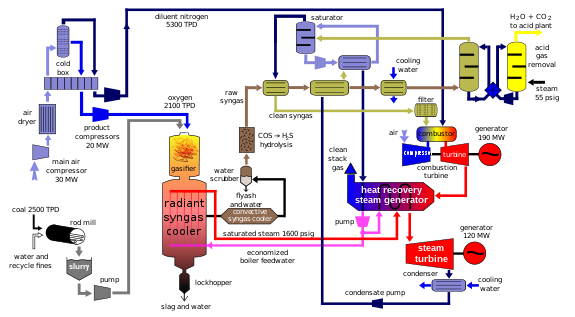
In a brilliant feat of legerdemain, China has demonstrated its own adroitness on the world energy scene. Anticipating the carbon-phobic stance of the incoming Obama / Pelosi reich, China has laid the foundation for supremacy in clean-coal IGCC (integrated gasification combined cycle) technology. Coal gasification is a critical component of any intelligent "bridge energy policy" meant to span the gap in time between the "
cheap oil age", and the "
abundant clean sustainable energy age".
Coal is an abundant energy resource worldwide, and using IGCC technology coal can be cleaner than most other current large-scale forms of energy production. But US carbon-hysteric politicians in the Obama / Pelosi reich are afraid of coal, and are unlikely to allow most large scale coal gasification projects to proceed. That carbon-phobic stance leaves the door wide open for any nation willing to develop this vital bridge energy technology.
The oil and gas giant BP reinforced China's position as a clean-coal technology leader last month, by establishing a $73 million research center in Shanghai with the Chinese Academy of Sciences to help commercialize technologies such as carbon capture and storage (CCS) and gasification. In another sign of the country's suddenly bold role in green technology, China's battery giant BYD launched the world's first mass-produced plug-in hybrid vehicle yesterday.
Underpinning China's potential leadership in carbon-neutral coal power is broad expertise with gasification. By 2010, China will have installed 29 gasification projects since 2004, compared with zero in the United States, according to the Gasification Technologies Council, a trade group based in Arlington, VA. Most of these Chinese projects turn coal into synthesis gas (or syngas)--a blend of carbon monoxide and hydrogen--to feed catalysts that synthesize chemicals and fuels. IGCC technology uses the same syngas to drive turbines and generate electricity with far less pollution than conventional coal plants. For example, mercury and soot levels are close to those seen at natural gas-fired plants, while carbon dioxide comes out in a pure stream that should be easier to capture and sequester.
...The project plans to start up a 250-megawatt IGCC plant in Tianjin in 2010 using a novel gasifier designed by the Thermal Power Research Institute in Xi'an; the plant will also supply some syngas and heat to local chemical plants. GreenGen plans to catapult the output of the gasifier design, from a 36-tons-per-day pilot plant, directly to commercial scale of 2,000 tons per day.
And GreenGen is already preparing to scale up further: in April, GreenGen and Tianjin officials signed an agreement for two 400-megawatt IGCC units. Meanwhile, Chinese utility firm Huaneng, GreenGen's majority stakeholder, started up a CCS pilot project at its Beijing coal power plant this summer. _TechReview
With the experience and expertise of building and operating large scale IGCC projects under their belts, Chinese enterprises will be in the driver's seat, energy-wise. As Europe and the Anglosphere grow more carbon-phobic and energy-starved, China will be the only one experienced enough with IGCC and "clean coal" to bail out the foolish carbon hysterics.
Of course if the west pursues advanced generation nuclear fission, or gets lucky with scalable nuclear fusion, coal can be used for making chemicals and polymers instead of energy and fuel -- sometime in the next 30 or 40 years. In the meantime, several decades will need to be spanned with some form of plentiful energy source.
China is betting on a sure thing, the same "sure thing" at which the Obama / Pelosi reich turns its nose up. In fact, the O / P reich turns its nose up at a lot of things, including oil sands, oil shale, coal, nuclear, offshore oil, arctic oil, and almost any other form of energy you can think of.
Solar thermal and geothermal are two likely sources of energy with big futures, which are also sustainable. In 20 or 30 years, they could both be a hugely important part of the energy portfolio. Wind is too unreliable for anyone but airheads to rely on it. Photovoltaics are still waiting for large scale energy storage that is affordable. Even biomass -- the best renewable -- will take decades to scale up to its potential.
Any way you slice it, coal gasification (IGCC is the best form), is a very good bet. You can judge the good players and the poor players by how they react to that technology.
Previously published at
Al FinLabels: coal, gasification, IGCC






